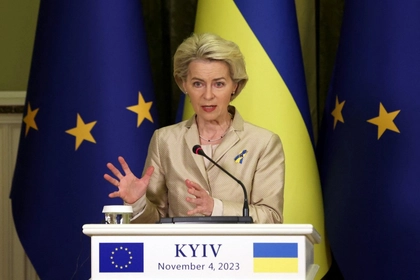U.S. and European officials are now talking publicly about Russia’s election meddling in Western countries, as well as Russia’s penetration of the media through assorted tactics that promote the Kremlin’s narrative on the war in Ukraine.
There is, however, another side to Russia’s active measures that must be confronted. We need to learn the lessons of both Putin’s invasion of Ukraine in 2014 and intervention in the Gulf Crisis of 2017 as, while the connection is poorly understood, they demonstrate the power of disinformation to advance the regime’s geopolitical objectives. These include taking over all of Ukraine, controlling the global energy market, and monopolizing a sizable percentage of the world’s grain supplies.
As to the Gulf Crisis in 2017, Russia did not openly choose sides, but Russian involvement in the crisis is clear, especially through cyber operations carried out by semi-independent hackers. In a familiar pattern, applied earlier with separatists warring in Ukraine, Russia leaked embarrassing details and nearly brought the disputing countries to the brink of war.
Given that Qatar is one of the top investors in Russia’s energy sector and Saudi Arabia’s reformists had more than once sided with the U.S. to beat back Russian attempts to raise oil prices, there was never any doubt of Putin’s covert commitment to Qatar and the Saudi Old Guard. He provided help by applying the smear campaign / character assassination model.

EU Transfers €1.5 Bln Raised From Russian Assets for Ukraine
Beyond short-term turmoil, which Russia always and almost everywhere sees as advantageous, the long-term objective was to establish credibility as a player in the region, damage relations between the Saudis, Emirati and Egyptians with the U.S., and ensure Gulf support for Russia’s future moves in energy and other areas.
Disinformation campaigns lionizing the pro-Muslim Brotherhood Washington Post contributor Jamal Khashoggi, while demonizing Saudi Crown Prince Mohammed bin Salman, took their toll on Saudi relations with the U.S., a feat Russia is trying to replicate now with its character assassination campaigns against President Zelensky and First Lady Olena Zelenska.
The aftermath of the Gulf Crisis was greater Russian influence, such that when Russia renewed its invasion of Ukraine in February 2022, Russian propagandists were able to count on popular support in the Arab world. Worse still, Arab States (and even Israel) have diverged from the U.S. in opposing Russia’s war against Ukraine and imposing sanctions.
Still, Russia was initially over-confident in the level of tacit support the international community would be willing to offer after the re-invasion, relying on Russia’s experiences following the 2014 invasion of Ukraine’s Crimean peninsula, and the similar invasions and annexations in Georgia and Transdniestria.
The spontaneous, organic outpouring of popular support for Ukraine in various Western countries shocked the Kremlin. Their great surprise only grew as they watched the unraveling of Russia’s military and diplomatic capabilities, as both the bravery of the Ukrainian resistance and the inhuman brutality of Russian invading forces across the world’s headlines and screens. The Kremlin’s propagandists were caught unprepared, and they could not wish away the terrible optics of their crimes: Russian soldiers massacring Ukrainian civilians, kidnapping children, and targeting cities for destruction to demoralize and intimidate the Ukrainian population.
However, Russia’s spin-masters were undeterred. They turned to their trusted black bag of tactics and began to find a way to get their narrative back on track bolstered by pockets of support in the West, Middle East and Africa.
As we have seen in prior generations, Russia’s disinformation specialists seek to exploit Western vulnerabilities, sow divisions within and between Western countries, and smear opponents to assassinate their characters even when they expect the big lie charges wouldn’t fully stick.
Russia knows that it could also count on time to take its toll on international attention, and that as the war wore on, the less prominent it would be in the minds of Westerners.
A combination of time and domestic concerns in the U.S. gave Russia what it needed to weaponize the victimization of Ukraine against itself.
Russian propagandists delighted in promoting a variety of attacks in the West in order to give both leaders on the left, and right, palliative reasons to undermine support for Ukraine.
Russia seeks to split the left away from supporting Ukraine by harping on about “white supremacists,” causing Democrats to believe that their sympathy for Kyiv is misplaced.
Russian fellow travelers and useful idiots have already gotten out the narratives that Ukrainian counterintelligence efforts against Russia’s vast network of spies are undemocratic and corrupt, as a way to counter Zelensky’s appeals to defend and support democracy and liberal reforms being implemented in Ukraine.
Confusing and misleading the public by muddying the waters is, according to the Kremlin’s playbook, always useful.
On the right, the Kremlin hopes that American Republicans might be enticed to oppose Ukraine as a means of opposing the unpopular President, who is a Democrat, and have preyed upon minor missteps by President Zelensky’s PR in an effort to portray Ukraine as corrupt and unsympathetic.
Most Americans, even media figures, are not aware that Biden’s family fortunes were tied to entities and governments that were heavily infiltrated by Russian interests and manipulated by pro-Russian oligarchs. None of that had anything to do with President Zelensky or with the current war.
By exploiting a sore point in the reactionary politics of the political opposition in the U.S., Russian active measures use Ukraine as a pawn in domestic U.S. political battles to advance Russia’s interests.
For instance, President Zelensky’s Vogue photo-shoot, organized to bring attention to Ukraine’s plight as the war is pushed into the background in American media by other news, was besmirched with allegations of corruption and mismanagement, and was exploited to attack U.S. financial support to Ukraine on social media, even among some people who had previously been sympathetic to the situation.
As Western attention drifted from Ukraine, Russia knew that if it could push a narrative of “weapons smuggling in Ukraine benefits neo-Nazis” it would already have won half the battle of dampening Western enthusiasm for supporting Ukraine militarily.
Russia’s efforts go far beyond what has become the heightened average of the past few years, as it employs a level of active measures and disinformation in the West not seen since every KGB officer had a quota to fulfil. Internally, the Soviet Union focused extensively on weaponizing ethnic grievances among occupied national populations, such as creating the fictional “Nagorno-Karabakh” enclave in Azerbaijan’s Karabakh region, which ultimately led to a prolonged conflict between Armenia and Azerbaijan, which we see flaring up again now.
The recent arrest of Aleksandr Viktorovich Ionov for election meddling in several U.S. states revealed that the ludicrous secession movement in California was yet one more example of “grassroots” efforts receiving support from the Kremlin.
Moscow has also abetted the secessionist movement in Spain’s Catalonia and backed Scottish independence. All of these examples would weaken both the ” parent ” countries and the “would be” states economically and politically, while advancing Russia’s agenda to consolidate power and influence in Europe and the United States.
While the West is focused narrowly on “elections hacking”, Russia has been preparing the ground for a more ambitious agenda among right-wing and left-wing persona and groups to corrupt the media, think tanks, and academia.
The proliferation of pro-Russian Westerners across the political extremes and increasingly in the mainstream demonstrates the deleterious effects of decades of continuous Soviet and now Russian operations on the body politic, as well as the heightened effectiveness of such interventions at the present time. Russia’s students and co-conspirators, like Iran, Venezuela, Cuba, China, and others, are similarly engaged.
A lot of Russian propaganda may appear primitive, crude, lacking in credibility, and of a conspiratorial mindset, but the polarized and distrustful West, in part polarized and distrustful because of past operations that weakened resolve and sowed doubts, is now fertile ground for receiving such messages.
If we look at the general pattern of Russia’s disinformation activity around the world, much of it is aimed at undercutting U.S. relations with potential allies, undermining confidence in the U.S.-backed global financial system, erasing sympathy for U.S. positions, advancing support for Russia as a viable geopolitical power broker, and minimizing the sting of sanctions or other political responses to Russia’s aggression.
The solution to Russia’s successful brokering of new alliances and wooing away of old friends in the West lies primarily in decoupling institutions of soft power from Russian interests, exposing Russian backing for damaging and polarizing social movements, and raising awareness of information warfare in the media and lobbies.
Russia has clarity about its goals in Ukraine, but has managed to confuse the average Westerner’s understanding of our own interests in preserving Ukraine’s security by exploiting political vulnerabilities and lack of preparedness.
Clear communication of our values, interests, and stakes is essential. We need both centralized and decentralized counter-disinformation that can be shared through soft power institutions and private citizens, who can take the message in creative directions as in the asymmetrical information warfare model of successful extremist movements and organizations.
We can be certain that Russia will continue to try to harm Ukraine’s national security interests by using disinformation campaigns, as it has done for generations. At this stage, the key is for Ukraine and the entire West to carefully reflect upon Russia’s long history in disinformation campaigns so as to be more proactive in identifying and countering active measures.
The views expressed in this article are the author’s and not necessarily those of the Kyiv Post
You can also highlight the text and press Ctrl + Enter






